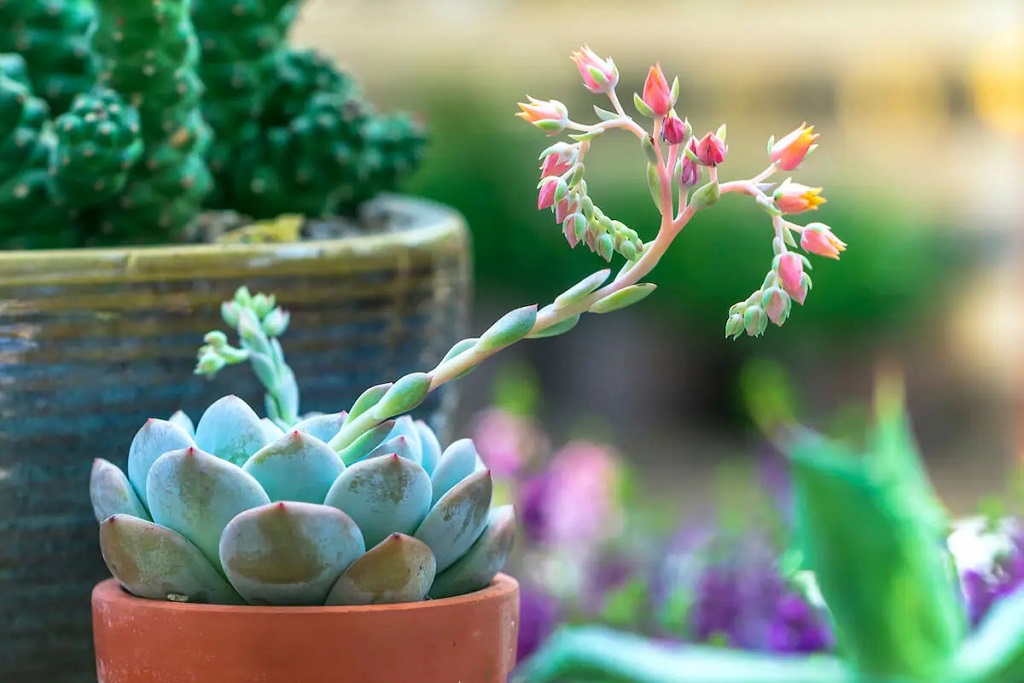Succulents have gained immense popularity among plant enthusiasts and gardeners, thanks to their distinctive traits and minimal upkeep demands. These plants have the remarkable capacity to hoard water in their leaves, which grants them resilience and versatility. A recurring inquiry among succulent proprietors revolves around the phenomenon of their plants flowering. This article delves into the intricacies of succulent flowering, elucidating the causative factors, the advantages it confers, and the proper care regimen for these blossoming succulents. And oh, by the way, have you ever wondered, what are the Stickers in Grass called? It’s a common query that can naturally find its place within our discussion.
Understanding Succulent Flowering
Succulent flowering is a natural part of the plant’s lifecycle. When succulents reach maturity, they have the potential to produce flowers. The timing and frequency of flowering can vary depending on the specific species of succulent. Some succulent species produce beautiful succulent yellow flowers that can brighten up any space.
Reasons for Succulent Flowering
There are several reasons why your succulent may be flowering:
Maturity
One of the main reasons succulents flower is that they have reached maturity. Once a succulent has established itself and grown to a certain size, it is more likely to produce flowers. This is a natural progression for the plant as it enters its reproductive phase.
Environmental Factors
The environment plays a significant role in triggering succulent flowering. Factors such as temperature, light exposure, and humidity can all influence a succulent’s decision to bloom. Certain succulent species may require specific conditions to initiate flowering.
Seasonal Changes
Succulents, like many other plants, can be influenced by changes in seasons. Some succulents, such as Christmas cacti, are known to flower during specific times of the year, often in response to changes in daylight hours. These seasonal cues signal the plant to begin the flowering process.
Benefits of Succulent Flowering
While succulent flowering may seem like an additional responsibility for plant owners, it offers several benefits:
Visual Appeal
Succulent flowers are a sight to behold. They come in a variety of shapes, sizes, and colors, adding visual interest to your garden or indoor space. The vibrant blooms can create a captivating focal point and enhance the overall aesthetics of your succulent collection.
Pollination
Succulent flowers play a crucial role in pollination. They attract pollinators such as bees, butterflies, and hummingbirds, which help transfer pollen from one flower to another. This process leads to fertilization and the production of fruits and seeds. By allowing your succulent to flower, you are supporting the natural ecosystem and promoting biodiversity.
Seed Propagation
Succulent flowers produce seeds that can be collected and propagated to grow new plants. This allows you to expand your succulent collection or share your plants with friends and family. Watching these seeds germinate and grow into thriving succulents can be a rewarding experience for any plant lover.
Caring for Flowering Succulents
Once your succulent starts flowering, it is important to provide the necessary care to ensure the health and longevity of the blooms:
Sunlight Exposure
Succulents require ample sunlight to thrive, including when they are flowering. Place your flowering succulent in a location where it can receive at least six hours of direct sunlight each day. If you are growing your succulents indoors, place them near a bright window or provide supplemental grow lights to compensate for the lack of natural light.
Proper Watering
While succulents are known for their ability to withstand drought, flowering succulents may require slightly more water than usual. Monitor the soil moisture level and water your succulent when the top inch of soil feels dry. Avoid overwatering, as excessive moisture can lead to root rot and affect the overall health of your succulent.
Fertilization
To support the growth and development of your flowering succulent, consider using a balanced fertilizer specifically formulated for succulents. Follow the instructions on the fertilizer package to ensure the proper application. Be careful not to over-fertilize, as this can cause nutrient burn and damage the plant.
Pruning and Deadheading
As your succulent flowers begin to fade and wilt, it is important to prune them to encourage new growth and maintain the plant’s appearance. Use clean scissors or pruning shears to carefully remove the spent flowers. This will redirect the plant’s energy towards producing new buds and blooms.
FAQs
Q1: How long do succulent flowers usually last?
Succulent flowers generally have a lifespan of a few days to a few weeks, depending on the species. However, individual flowers may open and close daily, extending their overall display period.
Q2: Can all succulents flower?
While most succulents have the potential to produce flowers, not all species are known for their blooms. Some succulents are primarily valued for their unique foliage and may rarely or never flower.
Q3: Do flowering succulents require special care?
Flowering succulents may require slightly different care compared to non-flowering ones. It is essential to provide adequate sunlight, water, and fertilization to support the blooming process.
Q4: Should I remove the flower stalk after the flowers have wilted?
Once the flowers on the stalk have wilted, you can remove the entire flower stalk. This will tidy up the appearance of the plant and direct its energy towards other growth aspects.
Q5: Can I propagate succulents from flowering stems?
Yes, some succulents can be propagated from flowering stems. After the flowers have withered, wait for the stem to dry out, and then carefully remove it. Allow the stem cutting to callous over for a few days before planting it in well-draining soil.
Conclusion
The flowering of your succulent is a natural process that adds beauty and diversity to your plant collection. Understanding the reasons behind succulent flowering can help you provide the appropriate care and create an environment that encourages healthy blooms. By considering factors such as maturity, environmental conditions, and seasonal changes, you can enjoy the benefits of succulent flowers and support the natural lifecycle of these unique plants. Remember to care for your flowering succulents by providing adequate sunlight, proper watering, and regular pruning. With the right care, your succulents will continue to flourish and delight you with their vibrant flowers.







